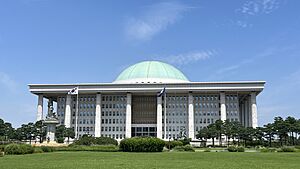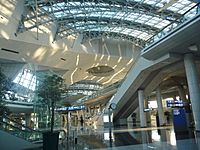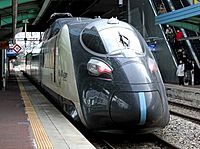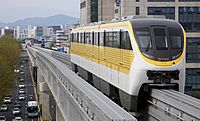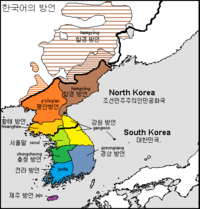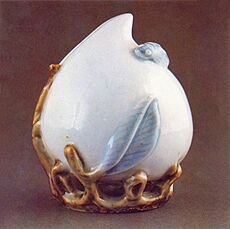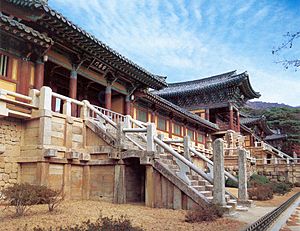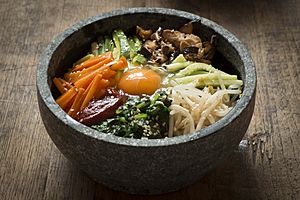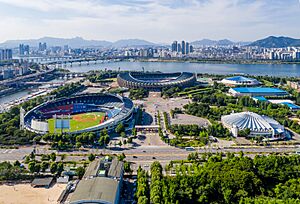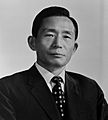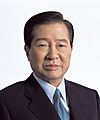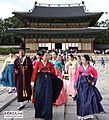South Korea facts for kids
Quick facts for kids
Republic of Korea
|
|
|---|---|
|
|
|

Territory controlled Territory claimed but not controlled
|
|
| Capital and largest city
|
Seoul 37°33′N 126°58′E / 37.550°N 126.967°E |
| Administrative center | Sejong City 36°29′13″N 127°16′56″E / 36.487002°N 127.282234°E |
| Official languages | Korean (Pyojuneo) Korean Sign Language |
| Official script | Hangul |
| Ethnic groups
(2024)
|
|
| Religion
(2024)
|
|
| Demonym(s) |
|
| Government | Unitary presidential republic |
| Han Duck-soo (acting) | |
| Han Duck-soo | |
|
• Speaker of the National Assembly
|
Woo Won-shik |
| Legislature | National Assembly |
| Establishment history | |
|
• Gojoseon
|
October 3, 2333 BCE (mythological) |
| 57 BCE | |
| 668 | |
|
• Goryeo dynasty
|
July 25, 918 |
|
• Joseon dynasty
|
August 13, 1392 |
| October 12, 1897 | |
| August 29, 1910 | |
|
• Independence from Japan declared
|
March 1, 1919 |
|
• Provisional Government
|
April 11, 1919 |
| August 15, 1945 | |
|
• US administration of Korea south of the 38th parallel
|
September 8, 1945 |
|
• ROK established
|
August 15, 1948 |
| February 25, 1988 | |
| Area | |
|
• Excl. North Korea
|
100,363 km2 (38,750 sq mi) (107th) |
|
• Water (%)
|
0.3 |
| Population | |
|
• 2024 estimate
|
|
|
• Density
|
507/km2 (1,313.1/sq mi) (15th) |
| GDP (PPP) | 2024 estimate |
|
• Total
|
|
|
• Per capita
|
|
| GDP (nominal) | 2024 estimate |
|
• Total
|
|
|
• Per capita
|
|
| Gini (2021) | ▼ 33.3 medium |
| HDI (2022) | very high · 19th |
| Currency | Korean Republic won (₩) (KRW) |
| Time zone | UTC+9 (Korea Standard Time) |
| Date format |
|
| Driving side | right |
| Calling code | +82 |
| ISO 3166 code | KR |
| Internet TLD | |
South Korea is a country in the southern part of the Korean peninsula, in the north east region of Asia. The capital city is Seoul. The official name of South Korea is the Republic of Korea in English, 대한민국 (Daehanminguk) in Korean writing (Hangeul), and 大韓民國 in Chinese characters (Hanja). About half of the country's people live in its capital city, Seoul, or near the city in the metropolitan area. Korea's Seoul metropolitan area is one of the most populous metropolitan areas in the world. In fact, some sources say it is the second most populous after Tokyo, Japan.
Contents
History
South Korea's history began with Dangunwanggeom's Gojoseon. Gojoseon was conquered by Han China. After Gojoseon collapsed, there were a lot of countries such as Buyeo, Okjeo, Dongyae and Samhan. But Baekje, Goguryeo and Silla were the strongest. So their period began, and it is called the Three Kingdoms Period. Goguryeo and Baekje were conquered by Silla and Dang China's allied forces, and Silla unified the three kingdoms. There was another country, Balhae. Balhae was founded by Dae Jo-Young. Later Silla and Balhae's period is called South and North Countries Period. A rebellion in Later Silla caused the birth of a new nation: Goryeo, which was founded by Wanggeon. Mongolia's invaded Goryeo. Near the end of the Goryeo period, there was a great general Lee Seong-Gye. The king of Goryeo directed him to occupy Yodong, but he opposed. However, Lee Seong-Gye went to Yodong to occupy it, but he returned to Goryeo and he revolted. His revolt succeeded, and he founded the country Joseon. Joseon's first king, Taejo, moved the capital to Hanyang (Seoul). Joseon's fourth king, Sejong, made the Korean alphabet, Hangeul. Joseon's twenty-second king, Jeongjo, built Hwaseong Fortress in Suwon. Joseon's twenty-sixth king, Gojong, changed the country's name to Daehanjeguk. When Daehanjaeguk's power weakened, Japan occupied it for 35 years until Japan's defeat in World War II in 1945. In 1950, there was a big war, the Korean War. As a result, Korea was divided into two countries, North and South.
Geography
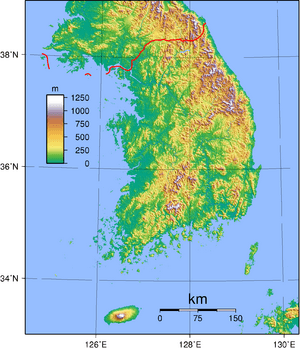
South Korea occupies the southern portion of the Korean Peninsula, which extends some 1,100 km (680 mi) from the Asian mainland. This mountainous peninsula is flanked by the Yellow Sea to the west, and the Sea of Japan to the east. Its southern tip lies on the Korea Strait and the East China Sea.
The country, including all its islands, lies between latitudes 33° and 39°N, and longitudes 124° and 130°E. Its total area is 100,032 square kilometers (38,622.57 sq mi).
South Korea can be divided into four general regions: an eastern region of high mountain ranges and narrow coastal plains; a western region of broad coastal plains, river basins, and rolling hills; a southwestern region of mountains and valleys; and a southeastern region dominated by the broad basin of the Nakdong River.
South Korea's terrain is mostly mountainous, most of which is not arable. Lowlands, located primarily in the west and southeast, make up only 30% of the total land area.
About three thousand islands, mostly small and uninhabited, lie off the western and southern coasts of South Korea. Jeju-do is about 100 kilometers (62 miles) off the southern coast of South Korea. It is the country's largest island, with an area of 1,845 square kilometers (712 square miles). Jeju is also the site of South Korea's highest point: Hallasan, an extinct volcano, reaches 1,950 meters (6,400 feet) above sea level. The easternmost islands of South Korea include Ulleungdo and Liancourt Rocks (Dokdo/Takeshima), while Marado and Socotra Rock are the southernmost islands of South Korea.
South Korea has 20 national parks and popular nature places like the Boseong Tea Fields, Suncheon Bay Ecological Park, and the first national park of Jirisan.
Climate
| Weather chart for Seoul | |||||||||||||||||||||||||||||||||||||||||||||||
|---|---|---|---|---|---|---|---|---|---|---|---|---|---|---|---|---|---|---|---|---|---|---|---|---|---|---|---|---|---|---|---|---|---|---|---|---|---|---|---|---|---|---|---|---|---|---|---|
| J | F | M | A | M | J | J | A | S | O | N | D | ||||||||||||||||||||||||||||||||||||
|
22
2
-6
|
24
4
-4
|
46
10
1
|
77
18
7
|
102
23
13
|
133
27
18
|
328
29
22
|
348
30
22
|
138
26
17
|
49
20
10
|
53
12
3
|
25
4
-3
|
||||||||||||||||||||||||||||||||||||
| temperatures in °C precipitation totals in mm |
|||||||||||||||||||||||||||||||||||||||||||||||
|
Imperial conversion
|
|||||||||||||||||||||||||||||||||||||||||||||||
South Korea tends to have a humid continental climate and a humid subtropical climate, and is affected by the East Asian monsoon, with precipitation heavier in summer during a short rainy season called jangma, which begins end of June and lasts through the end of July. In Seoul, the average January temperature range is −7 to 1 °C (19 to 34 °F), and the average August temperature range is 22 to 30 °C (72 to 86 °F). Winter temperatures are higher along the southern coast and considerably lower in the mountainous interior. Summer can be uncomfortably hot and humid, with temperatures exceeding 30 °C (86 °F) in most parts of the country. South Korea has four distinct seasons; spring, summer, autumn and winter. Spring usually lasts from late March to early May, summer from mid-May to early September, autumn from mid-September to early November, and winter from mid-November to mid-March.
Rainfall is concentrated in the summer months of June through September. The southern coast is subject to late summer typhoons that bring strong winds, heavy rains and sometimes floods. The average annual precipitation varies from 1,370 millimeters (54 in) in Seoul to 1,470 millimeters (58 in) in Busan.
Government and politics
The South Korean government's structure is determined by the Constitution of the Republic of Korea. Like many democratic states, South Korea has a government divided into three branches: executive, judicial, and legislative. The executive and legislative branches operate primarily at the national level, although various ministries in the executive branch also carry out local functions. The judicial branch operates at both the national and local levels. Local governments are semi-autonomous and contain executive and legislative bodies of their own. South Korea is a constitutional democracy.
The constitution has been revised several times since its first promulgation in 1948 at independence. However, it has retained many broad characteristics and with the exception of the short-lived Second Republic of Korea, the country has always had a presidential system with an independent chief executive. Under its current constitution the state is sometimes referred to as the Sixth Republic of Korea. The first direct election was also held in 1948.
Although South Korea experienced a series of military dictatorships from the 1960s until the 1980s, it has since developed into a successful liberal democracy.
Administrative divisions
The major administrative divisions in South Korea are eleven provinces, three special self-governing provinces, six metropolitan cities (self-governing cities that are not part of any province), one special metropolitan city and one special self-governing city.
| Map | Name (city/ province) | Hangul | Hanja | Populationc | ||
|---|---|---|---|---|---|---|
| Special metropolitan city (Teukbyeol-si)a | ||||||
| Seoul | 서울특별시 | 서울特別市b | 9,830,452 | |||
| Metropolitan city (Gwangyeok-si)a | ||||||
| Busan | 부산광역시 | 釜山廣域市 | 3,460,707 | |||
| Daegu | 대구광역시 | 大邱廣域市 | 2,471,136 | |||
| Incheon | 인천광역시 | 仁川廣域市 | 2,952,476 | |||
| Gwangju | 광주광역시 | 光州廣域市 | 1,460,972 | |||
| Daejeon | 대전광역시 | 大田廣域市 | 1,496,123 | |||
| Ulsan | 울산광역시 | 蔚山廣域市 | 1,161,303 | |||
| Special self-governing city (Teukbyeol-jachi-si)a | ||||||
| Sejong | 세종특별자치시 | 世宗特別自治市 | 295,041 | |||
| Province (Do)a | ||||||
| Gyeonggi | 경기도 | 京畿道 | 12,941,604 | |||
| North Chungcheong | 충청북도 | 忠淸北道 | 1,595,164 | |||
| South Chungcheong | 충청남도 | 忠淸南道 | 2,120,666 | |||
| South Jeolla | 전라남도 | 全羅南道 | 1,890,412 | |||
| North Gyeongsang | 경상북도 | 慶尙北道 | 2,682,897 | |||
| South Gyeongsang | 경상남도 | 慶尙南道 | 3,377,126 | |||
| Special self-governing province (Teukbyeol-jachi-do)a | ||||||
| Jeju | 제주특별자치도 | 濟州特別自治道 | 661,511 | |||
| Gangwon | 강원특별자치도 | 江原特別自治道 | 1,545,452 | |||
| North Jeolla | 전북특별자치도 | 全北特別自治道 | 1,847,089 | |||
| Claimed Province but not controlled (North Korea) | ||||||
| North Hamgyeong | 함경북도 | 咸鏡北道 | — | |||
| South Hamgyeong | 함경남도 | 咸鏡南道 | — | |||
| North Pyeongan | 평안북도 | 平安北道 | — | |||
| South Pyeongan | 평안남도 | 平安南道 | — | |||
| Hwanghae | 황해도 | 黃海道 | — | |||
Transportation, energy and infrastructure
South Korea has a technologically advanced transport network consisting of high-speed railways, highways, bus routes, ferry services, and air routes that crisscross the country. Korea Expressway Corporation operates the toll highways and service amenities en route.
Korail provides frequent train services to all major South Korean cities. Two rail lines, Gyeongui and Donghae Bukbu Line, to North Korea are now being reconnected. The Korean high-speed rail system, KTX, provides high-speed service along Gyeongbu and Honam Line. Major cities including Seoul, Busan, Incheon, Daegu, Daejeon and Gwangju have urban rapid transit systems. Express bus terminals are available in most cities.
South Korea's main gateway and largest airport is Incheon International Airport, serving 58 million passengers in 2016. Other international airports include Gimpo, Busan and Jeju. There are also many airports that were built as part of the infrastructure boom but are barely used. There are also many heliports.
The national carrier, Korean Air served over 26,800,000 passengers, including almost 19,000,000 international passengers in 2016. A second carrier, Asiana Airlines also serves domestic and international traffic. Combined, South Korean airlines serve 297 international routes. Smaller airlines, such as Jeju Air, provide domestic service with lower fares.
South Korea is the world's fifth-largest nuclear power producer and the second-largest in Asia as of 2010[update]. Nuclear power in South Korea supplies 45% of electricity production, and research is very active with investigation into a variety of advanced reactors, including a small modular reactor, a liquid-metal fast/transmutation reactor and a high-temperature hydrogen generation design. Fuel production and waste handling technologies have also been developed locally. It is also a member of the ITER project.
South Korea is an emerging exporter of nuclear reactors, having concluded agreements with the UAE to build and maintain four advanced nuclear reactors, with Jordan for a research nuclear reactor, and with Argentina for construction and repair of heavy-water nuclear reactors. As of 2010[update], South Korea and Turkey are in negotiations regarding construction of two nuclear reactors. South Korea is also preparing to bid on construction of a light-water nuclear reactor for Argentina.
South Korea is not allowed to enrich uranium or develop traditional uranium enrichment technology on its own, because of US political pressure, unlike most major nuclear powers such as Japan, Germany, and France, competitors of South Korea in the international nuclear market. This impediment to South Korea's indigenous nuclear industrial undertaking has sparked occasional diplomatic rows between the two allies. While South Korea is successful in exporting its electricity-generating nuclear technology and nuclear reactors, it cannot capitalize on the market for nuclear enrichment facilities and refineries, preventing it from further expanding its export niche. South Korea has sought unique technologies such as pyroprocessing to circumvent these obstacles and seek a more advantageous competition. The US has recently been wary of South Korea's burgeoning nuclear program, which South Korea insists will be for civilian use only.
South Korea is the third highest ranked Asian country in the World Economic Forum's Network Readiness Index (NRI) after Singapore and Hong Kong respectively – an indicator for determining the development level of a country's information and communication technologies. South Korea ranked number 10 overall in the 2014 NRI ranking, up from 11 in 2013.
Science and technology
South Korea is a very rich country and is known for a lot of technology. This includes the car-maker Hyundai. The well-known global brand Samsung, which makes mobile phones, semi-conductors and electric devices, is also South Korean.
Demographics
South Korea had an estimated population of roughly 51.7 million in 2022. The country is noted for its population density, which was an estimated 514.6 per square kilometre (1,333/sq mi) in 2022, more than 10 times the global average.
Most South Koreans live in urban areas following rapid migration from the countryside during the country's rapid economic expansion in the 1970s through the 1990s. About half the population (24.5 million) is concentrated in the Seoul National Capital Area, making it the world's second largest metropolitan area; other major cities include Busan (3.5 million), Incheon (3.0 million), Daegu (2.5 million), Daejeon (1.4 million), Gwangju (1.4 million) and Ulsan (1.1 million).
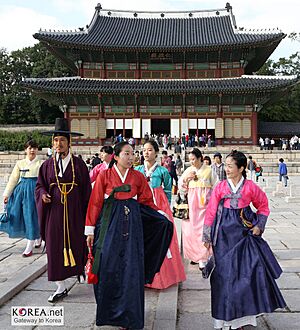
South Korea is considered one of the most ethnically homogeneous societies in the world, with ethnic Koreans representing approximately 96% of total population.
Language
Korean is the official language of South Korea and is classified by most linguists as a language isolate. It incorporates a significant number of loan words from Chinese. Korean uses an indigenous writing system called Hangul, created in 1446 by King Sejong, to provide a convenient alternative to the Classical Chinese Hanja characters that were difficult to learn and did not fit the Korean language well. South Korea still uses some Chinese Hanja characters in limited areas, such as print media and legal documentation.
The Korean language in South Korea has a standard dialect known as the Seoul dialect, with an additional four dialects (Chungcheong, Gangwon, Gyeongsang, and Jeolla) and one language (Jeju) in use around the country. Almost all South Korean students today learn English throughout their education.
Religion
Religion in South Korea (2015 census) Irreligious (56.1%) Protestantism (19.7%) Korean Buddhism (15.5%) Catholicism (7.9%) Other (0.8%)
According to the results of the census of 2015, more than half of the South Korean population (56.1%) declared themselves not affiliated with any religious organizations. In a 2012 survey, 52% declared themselves "religious", 31% said they were "not religious" and 15% identified themselves as "convinced atheists". Of the people who are affiliated with a religious organization, most are Christians and Buddhists. According to the 2015 census, 27.6% of the population were Christians (19.7% identified themselves as Protestants, 7.9% as Roman Catholics) and 15.5% were Buddhists. Other religions include Islam (130,000 Muslims, mostly migrant workers from Pakistan and Bangladesh but including some 35,000 Korean Muslims), the homegrown sect of Won Buddhism, and a variety of indigenous religions, including Cheondoism (a Confucianizing religion), Jeungsanism, Daejongism, Daesun Jinrihoe, and others. Freedom of religion is guaranteed by the constitution, and there is no state religion.
Culture
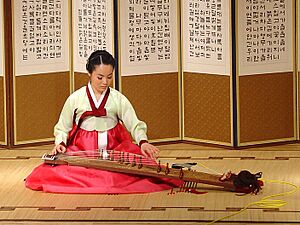
South Korea shares its traditional culture with North Korea, but the two Koreas have developed distinct contemporary forms of culture since the peninsula was divided in 1945. Historically, while the culture has been heavily influenced by that of neighboring China, it has nevertheless independently managed to develop a unique cultural identity in its own right that is distinct from that of its larger neighbor on the East Asian mainland. Its rich and vibrant culture left 21 UNESCO Intangible Cultural Heritages of Humanity, the fourth largest in the world, along with 15 World Heritage Sites. The Ministry of Culture, Sports and Tourism actively encourages the traditional arts, as well as modern forms, through funding and education programs. According to the 2023 edition of the Press Freedom Index, South Korea has the second highest level of press freedom in Continental and East Asia, behind Taiwan.
Industrialization and urbanization have brought many changes to the way modern Koreans live. Changing economic circumstances and lifestyles have led to a concentration of population in major cities, especially the capital Seoul, with multi-generational households separating into nuclear family living arrangements.
Art
Korean art has been highly influenced by Buddhism and Confucianism, which can be seen in the many traditional paintings, sculptures, ceramics and the performing arts. Korean pottery and porcelain, such as Joseon's baekja and buncheong, and Goryeo's celadon are well known throughout the world. The Korean tea ceremony, pansori, talchum, and buchaechum are also notable Korean performing arts.
Post-war modern Korean art started to flourish in the 1960s and 1970s, when South Korean artists took interest in geometrical shapes and intangible subjects. Establishing a harmony between man and nature was also a favorite of this time. Because of social instability, social issues appeared as main subjects in the 1980s. Art was influenced by various international events and exhibits in Korea, which brought more diversity. The Olympic Sculpture Garden in 1988, the transposition of the 1993 edition of the Whitney Biennial to Seoul, the creation of the Gwangju Biennale and the Korean Pavilion at the Venice Biennale in 1995 were notable events.
Architecture
Because of South Korea's tumultuous history, construction and destruction has been repeated endlessly, resulting in an interesting melange of architectural styles and designs.
Traditional Korean architecture is characterized by its harmony with nature. Ancient architects adopted the bracket system characterized by thatched roofs and heated floors called ondol. People of the upper classes built bigger houses with elegantly curved tiled roofs and lifting eaves. Traditional architecture can be seen in the palaces and temples, preserved old houses called hanok, and special sites like Hahoe Folk Village, Yangdong Folk Village and Korean Folk Village. Traditional architecture may also be seen at several of the UNESCO World Heritage Sites.
Western architecture was first introduced at the end of the 19th century. Churches, offices for foreign legislation, schools and university buildings were built in new styles. With the annexation by Japan in 1910 the colonial regime intervened in Korea's architectural heritage, and Japanese-style modern architecture was imposed. Anti-Japanese sentiment and the Korean War led to the destruction of most buildings constructed during that time.
Modern Korean architecture entered a new phase of development during the post-Korean War reconstruction, incorporating modern architectural trends and styles. Stimulated by the economic growth in the 1970s and 1980s, active redevelopment saw new horizons in architectural design. In the aftermath of the 1988 Seoul Olympics, South Korea has witnessed a wide variation of styles in its architectural landscape with the opening up of the market to foreign architects. Contemporary architectural efforts have attempted to balance the traditional philosophy of "harmony with nature" and the fast-paced urbanization that the country has been going through in recent years.
Entertainment

In addition to domestic consumption, South Korea has a thriving entertainment industry where various facets of South Korean entertainment, including television dramas, films, and popular music, have garnered international popularity and generated significant export revenues for the nation's economy. The cultural phenomenon known as Hallyu or the "Korean Wave", has swept many countries across Continental and East Asia making South Korea a major soft power as an exporter of popular culture and entertainment, rivaling Western nations such as the United States and the United Kingdom.
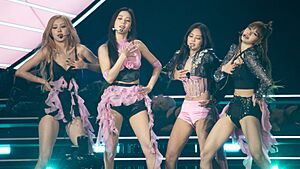
Until the 1990s, trot and traditional folk-based ballads dominated the South Korean popular music scene. The emergence of the pop group Seo Taiji and Boys in 1992 marked a turning point for South Korean popular music, also known as K-pop. Since the 1990s, the genre of K-pop has continuously engaged in a process of ongoing reinvention and modernization by assimilating various elements of popular musical genres and trends from across the world such as Western popular music, experimental, jazz, gospel, Latin, hip hop, rhythm and blues, electronic dance, reggae, country, folk, and rock on top of its uniquely traditional Korean music roots. Though Western-style pop, hip hop, rhythm and blues, rock, folk, electronic dance oriented acts have become dominant in the contemporary South Korean popular music scene, trot still continues to be appreciated and enjoyed by older South Koreans. K-pop idols are well known across Continental Asia, have found fame in the Western World, and have generated millions of dollars in export revenue beyond the confines of the traditional East Asian music market. Many K-pop acts have also established themselves by securing a strong global following using online social media platforms such as YouTube. K-pop first began to make its mark outside of Continental and East Asia following the unexpected success of singer Psy's international music sensation, "Gangnam Style", which topped global music charts in 2012.
Since the success of the film Shiri in 1999, the Korean film industry has grown substantially, garnering recognition both nation-wide and across the globe. Domestic films have a dominant share of the South Korean film market, partly because of the existence of government screen quotas requiring cinemas to show Korean films for at least 73 days of the year. 2019's Parasite, directed by Bong Joon-ho, became the highest-grossing film in South Korea as well as the first non-English language film to win Best Picture at the United States-based Academy Awards that year amongst numerous other accolades.
South Korean television shows have become popular outside of Korea. Television dramas, known as K-dramas, have begun to find fame internationally. Many dramas tend to have a romantic focus. Historical dramas are also famous. The 2021 survival drama Squid Game, created by Hwang Dong-hyuk, received critical acclaim and widespread international attention upon its release, becoming Netflix's most-watched series at launch and garnering a viewership of more than 142 million households during its first four weeks from launch.
Holidays
The Korean New Year, or "Seollal", is celebrated on the first day of the Korean calendar. Korean Independence Day falls on March 1 and commemorates the March First Movement of 1919. Memorial Day is celebrated on June 6, and its purpose is to honor the men and women who died in South Korea's independence movement. Constitution Day is on July 17, and it celebrates the promulgation of Constitution of the Republic of Korea. Liberation Day, on August 15, celebrates Korea's liberation from the Empire of Japan in 1945.
Every 15th day of the 8th lunar month, Koreans celebrate the Midautumn Festival, in which Koreans visit their ancestral hometowns and eat a variety of traditional Korean foods. On October 1, Armed Forces Day is celebrated, honoring the military forces of South Korea. October 3 is National Foundation Day. Hangul Day on October 9 commemorates the invention of hangul, the native alphabet of the Korean language.
Cuisine
Korean cuisine, hanguk yori, or hansik, has evolved through centuries of social and political change. Ingredients and dishes vary by province. There are many significant regional dishes that have proliferated in different variations across the country in the present day. The Korean royal court cuisine once brought all of the unique regional specialties together for the royal family. Meals consumed both by the royal family and ordinary citizens have been regulated by a unique culture of etiquette.
Korean cuisine is largely based on rice, noodles, tofu, vegetables, fish and meats. Traditional meals are noted for the number of side dishes, banchan, which accompany steam-cooked short-grain rice. Every meal is accompanied by numerous banchan. Kimchi, a fermented, usually spicy vegetable dish is commonly served at every meal and is one of the best known dishes. Korean cuisine usually involves heavy seasoning with sesame oil, doenjang (a type of fermented soybean paste), soy sauce, salt, garlic, ginger, and gochujang (a hot pepper paste). Other well-known dishes are bulgogi, grilled marinated beef; gimbap; and tteokbokki, a spicy snack consisting of rice cake seasoned with gochujang or a spicy chili paste.
Soups are also a common part of a meal and are served as part of the main course rather than at the beginning or the end of the meal. Soups known as guk are often made with meats, shellfish and vegetables. Similar to guk, tang has less water and is more often served in restaurants. Another type is jjigae, a stew that is typically heavily seasoned with chili pepper and served boiling hot.
Popular Korean alcoholic drinks include Soju, Makgeolli and Bokbunja ju. Korea is unique among East Asian countries in its use of metal chopsticks. Metal chopsticks have been discovered in Goguryeo archaeological sites.
Sports
The martial art taekwondo originated in Korea. In the 1950s and 1960s, modern rules were standardized, with taekwondo becoming an official Olympic sport in 2000. Other Korean martial arts include Taekkyon, hapkido, Tang Soo Do, Kuk Sool Won, kumdo and subak.
Football has traditionally been regarded as the most popular sport in Korea, with baseball as the second. Recent polling indicates that a majority, 41% of South Korean sports fans continue to self-identify as football fans, with baseball ranked 2nd at 25% of respondents. However, the polling did not indicate the extent to which respondents follow both sports.
The national football team became the first team in the Asian Football Confederation to reach the FIFA World Cup semi-finals in the 2002 FIFA World Cup, jointly hosted by South Korea and Japan. The Korea Republic national team (as it is known) has qualified for every World Cup since Mexico 1986, and has broken out of the group stage in 2002, in 2010, when it was defeated by eventual semi-finalist Uruguay in the Round of 16, and in 2022. At the 2012 Summer Olympics, South Korea won the bronze medal for football.
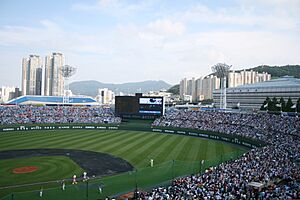
Baseball was first introduced to Korea in 1905. Recent years have been characterized by increasing attendance and ticket prices for professional baseball games. The Korea Professional Baseball league, a 10-team circuit, was established in 1982. The South Korea national team finished third in the 2006 World Baseball Classic and second in the 2009 tournament. The team's 2009 final game against Japan was widely watched in Korea, with a large screen at Gwanghwamun crossing in Seoul broadcasting the game live. In the 2008 Summer Olympics, South Korea won the gold medal in baseball. Also in 1982, at the Baseball Worldcup, Korea won the gold medal. At the 2010 Asian Games, the Korean National Baseball team won the gold medal. Several Korean players have gone on to play in Major League Baseball.
Basketball is a popular sport in the country as well. South Korea has traditionally had one of the top basketball teams in Asia and one of the continent's strongest basketball divisions. Seoul hosted the 1967 and 1995 Asian Basketball Championship. The Korea national basketball team has won a record number of 23 medals at the event to date.
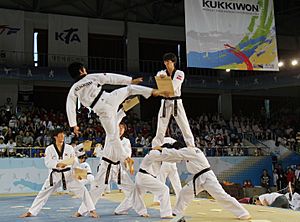
South Korea hosted the Asian Games in 1986 (Seoul), 2002 (Busan), and 2014 (Incheon). It also hosted the Winter Universiade in 1997, the Asian Winter Games in 1999, and the Summer Universiade in 2003 and 2015. In 1988, South Korea hosted the Summer Olympics in Seoul, coming fourth with 12 gold medals, 10 silver medals, and 11 bronze medals. South Korea regularly performs well in archery, shooting, table tennis, badminton, short track speed skating, handball, field hockey, freestyle wrestling, Greco-Roman wrestling, baseball, judo, taekwondo, speed skating, figure skating, and weightlifting. The Seoul Olympic Museum is dedicated to the 1988 Summer Olympics.
Pyeongchang hosted the 2018 Winter Olympics. South Korea has won more medals in the Winter Olympics than any other Asian country, with a total of 45 (23 gold, 14 silver, and 8 bronze). At the 2010 Winter Olympics, South Korea ranked fifth in the overall medal rankings. South Korea is especially strong in short track speed skating. Speed skating and figure skating are also popular, and ice hockey is an emerging sport, with Anyang Halla winning their first ever Asia League Ice Hockey title in March 2010.
Seoul hosted a professional triathlon race, which is part of the International Triathlon Union (ITU) World Championship Series in 2010. In 2011, the South Korean city of Daegu hosted the 2011 IAAF World Championships in Athletics. In 2010, South Korea hosted its first Formula One race at the Korea International Circuit in Yeongam. The Korean Grand Prix was held from 2010 to 2013.
Domestic horse racing events are followed by South Koreans and Seoul Race Park in Gwacheon, Gyeonggi Province is located closest to Seoul out of the country's three tracks.
Competitive video gaming, also called esports, has become more popular in South Korea in recent years, particularly among young people. The two most popular games are League of Legends and StarCraft. The gaming scene is managed by the Korean e-Sports Association.
Images for kids
-
The name Korea is derived from Goguryeo, also known as Koryŏ, one of the Three Kingdoms of Korea.
-
Changdeok Palace, one of the Five Grand Palaces built during the Joseon Dynasty and another UNESCO World Heritage Site
-
The War Memorial of Korea, built in remembrance of the Korean War (1950–1953)
-
President Park Chung-hee played a pivotal role in rapidly developing South Korea's economy through export-oriented industrialization.
-
President Kim Dae-jung, the 2000 Nobel Peace Prize recipient for advancing democracy and human rights in South Korea and East Asia and for reconciliation with North Korea, was sometimes called the "Nelson Mandela of Asia."
-
Cheonggyecheon river is a modern public recreation space in downtown Seoul.
-
Seoul National University is considered to be the most prestigious university in South Korea.
-
KAIST main campus in Daejeon
-
Former Secretary-General of the United Nations (2007–2016), Ban Ki-moon
-
North Korean leader Kim Jong-un and South Korean President Moon Jae-in shake hands inside the Peace House
-
South Korean president Moon Jae-in meets with Russian president Vladimir Putin
-
Liancourt Rocks have become an issue known as the Liancourt Rocks dispute.
-
President Moon Jae-in and U.S. President Joe Biden having lunch on 21 May 2021, on the Oval Office Patio of the White House
-
Haeundae Beach in Busan
-
BTS, one of the most successful K-pop groups
See also
 In Spanish: Corea del Sur para niños
In Spanish: Corea del Sur para niños





